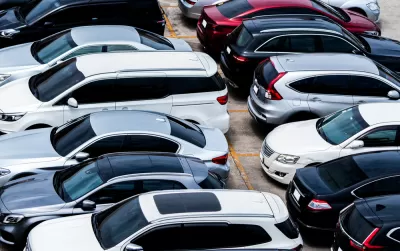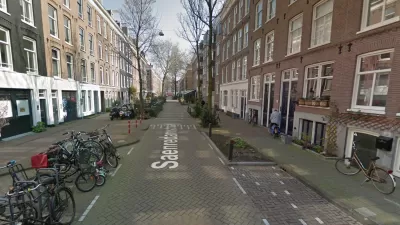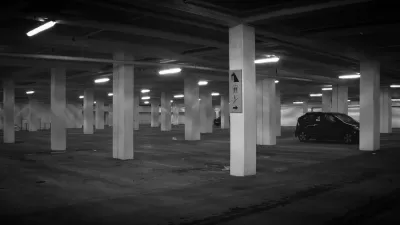As American vehicles grow taller, wider, and longer, more of them are having a hard time fitting in traditional parking spaces.

“Increasingly, cars are too big for parking spaces, especially in parking garages and other paid parking lots where developers pay close attention to space size,” writes Aaron Gordon in Vice. “Like the proverbial frog in a slowly heating pot of water, our cars have gotten ever-so-gradually bigger with each passing year, but the parking space standards have barely budged.”
Gordon describes the process by which parking lot designers decide space sizes, which uses the 85th percentile car size. “This approach to designing parking spaces has historically served the parking industry well, ensuring space sizes accommodate the vast majority of American cars and leaving about 20 inches of space for people to open their doors and maneuver on either side.”
But now, “the 85th percentile method is not capturing the changes in the car sizes. The size of the 10th percentile car has exploded. The size of the 50th percentile car has grown tremendously. The size of the 70th percentile car has also grown. But the 85th percentile car is essentially the Ford F-150, which is much taller and longer than it used to be, but no wider.”
With parking spaces costing thousands or even tens of thousands of dollars each to build, even a few inches can make a significant difference in a project’s budget. To build larger spaces, developers will have to raise the cost of parking for everyone—or just for larger cars, like some parking lots in cities like New York already do. “It’s easy to imagine the backlash that may ensue from any effort to charge people with large vehicles more for parking, even though the suggestion that people who use more of something should pay more than people who use less is one of the most basic tenets of economic theory and the basis of capitalism.” But larger cars don't just take up more space—they pose increased safety risks, too.
FULL STORY: American Cars Are Getting Too Big For Parking Spaces

Alabama: Trump Terminates Settlements for Black Communities Harmed By Raw Sewage
Trump deemed the landmark civil rights agreement “illegal DEI and environmental justice policy.”

Study: Maui’s Plan to Convert Vacation Rentals to Long-Term Housing Could Cause Nearly $1 Billion Economic Loss
The plan would reduce visitor accommodation by 25% resulting in 1,900 jobs lost.

Why Should We Subsidize Public Transportation?
Many public transit agencies face financial stress due to rising costs, declining fare revenue, and declining subsidies. Transit advocates must provide a strong business case for increasing public transit funding.

Paris Bike Boom Leads to Steep Drop in Air Pollution
The French city’s air quality has improved dramatically in the past 20 years, coinciding with a growth in cycling.

Why Housing Costs More to Build in California Than in Texas
Hard costs like labor and materials combined with ‘soft’ costs such as permitting make building in the San Francisco Bay Area almost three times as costly as in Texas cities.

San Diego County Sees a Rise in Urban Coyotes
San Diego County experiences a rise in urban coyotes, as sightings become prevalent throughout its urban neighbourhoods and surrounding areas.
Urban Design for Planners 1: Software Tools
This six-course series explores essential urban design concepts using open source software and equips planners with the tools they need to participate fully in the urban design process.
Planning for Universal Design
Learn the tools for implementing Universal Design in planning regulations.
Smith Gee Studio
Alamo Area Metropolitan Planning Organization
City of Santa Clarita
Institute for Housing and Urban Development Studies (IHS)
City of Grandview
Harvard GSD Executive Education
Toledo-Lucas County Plan Commissions
Salt Lake City
NYU Wagner Graduate School of Public Service





























